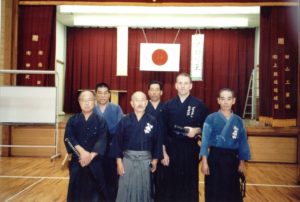Muso Jikiden Eishin Ryu Iai Jutsu

Sensei Brian Hinchliffe has been very fortunate over the years to have met and studied with some excellent teachers of the Japanese sword Art called Muso Jikiden Eishin Ryu Iai Jutsu in Japan. Having first tried Kendo, Iaido and Jo Jutsu whilst staying at the Obaku-San Manpuku-Ji temple near Uji, just outside of Kyoto, Brian eventually met Shimabukuro Masayuki Hanshi (1948-2012) and studied with the Jikishin Kai. Then was introduced to Morinaka Masakatsu Sensei Menkyo Kaiden (1929-2013) and became his personal student. Morinaka Sensei was a direct Student of Iwata Norikazu Sensei Menkyo Kaiden (1913-2010) and studied the finer points of both Tanimura-ha and Shimomura-ha schools of Jikiden as they have been passed down on Shikoku Island (Tosa Eishin Ryu) and across Japan. Brian Hinchliffe also received the Menkyo certificate for Shimomura-ha directly from Morinaka Sensei. Whilst there are no public classes for Japanese swordsmanship currently being taught within the Ho Ei Juku, there are occasional seminars organised within the ZNSBR where anyone with an interest in studying this fascinating Art form can experience the work that goes into achieving success as handling one of the world’s most famous weapons. Training includes practice of individual technique, pair work and test cutting.
The roots of this Japanese sword Art can be traced back to 16th Century Japan, when a young samurai, Hayashizaki Jinsuke (1546-1621), allegedly created a sword technique to avenge the death of his father. He came from the area now known as Yamagata-Ken in northern Japan. Over the generations, the sword Art was passed from teacher to student and several of the subsequent masters are still known today for their expertise in using the sword. Hasegawa Eishin from Shikoku (Tosa) became the 7th Generation master and greatly influenced the development of this sword school at a time when samurai swordsmanship was changing from mainly cavalry to more often being foot soldiers. During the time of the 12th and 13th generation masters, the school was divided into two factions, the Tanimura-ha and Shimomura-ha. There are distinct differences in the approach to using a sword within these variations and it was not until the time of the legendary Oe Masamichi sensei (1852-1927) from Shikoku (Tosa) that Muso Jikiden Eishin Ryu became unified once more. Oe Masamichi sensei standardised the techniques practiced, eliminated some duplication and produced the syllabus known to us today. Students of Oe Masamichi were instrumental in assisting the Japanese military to compile a simplified school of swordsmanship for use during the conflicts of the 20th Century. Iaido is now practiced around the world in an almost philosophical manner as a method of moving meditation, to develop mind, body and spirit in the perfection of a perfect technique within the parameters laid down by the generations that have gone before. We are fortunate to have so many memories of the direct teachings of Morinaka Sensei R.I.P.

